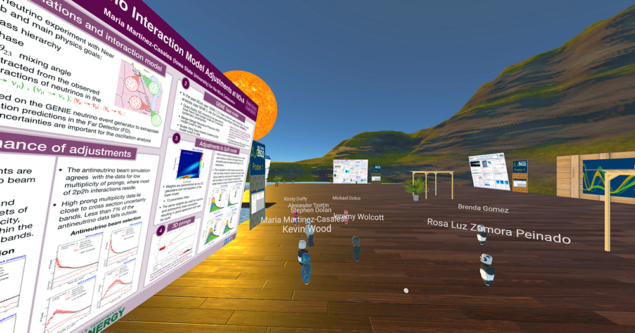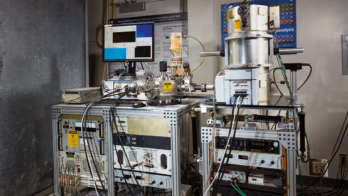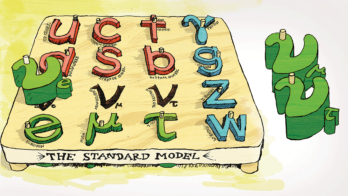
4,350 people from every continent, including Antarctica, participated from 22 June to 2 July in the XXIX International Conference on Neutrino Physics and Astrophysics, which was hosted online by Fermilab and the University of Minnesota. Originally planned as a five day, in-person June meeting at a large hotel in Chicago city centre, the organisers quickly pivoted in March, due to COVID-19, to an online programme with eight half days over two weeks, four poster sessions with both web-based and virtual-reality displays, and the use of the Slack platform for speaker questions and ongoing discussions.
A highlight of the conference was the first observation of solar CNO neutrinos
A highlight of the conference was the first observation of solar CNO neutrinos by the Borexino collaboration, which operates a 280-tonne liquid-scintillator detector in Italy’s Gran Sasso Laboratory. Dominant in stars more than 1.3 times the mass of the sun, the CNO cycle accounts for about 1% of the sun’s energy and generates a difficult-to-detect neutrino flux similar to backgrounds due to decays in the detector of 210Bi and its daughter nucleus 210Po. Gioacchino Ranucci (INFN, Milano) explained that the spectral fit to the observed data returns only the sum of CNO and 210Bi neutrinos. “The quest for CNO is turned into the quest for 210Bi through 210Po,” he emphasised. “With this outcome, Borexino has completely unravelled the two processes powering the Sun—the pp chain and the CNO cycle.” The final data analysis yielded a 5.1σ statistic against a hypothesis of no CNO neutrinos, and a CNO flux at the Earth of 7.0-1.9+2.9 × 108 cm-2 s-1.
Another highlight from Gran Sasso was the report from the Gerda collaboration on the search for neutrino-less double beta decay. If observed, this process would confirm the long-suspected Majorana rather than Dirac-fermion nature of neutrinos – a beyond the Standard Model feature with intriguing implications for why the neutrino mass is so small. Since Neutrino 2018, Gerda has nearly doubled its Phase 2 exposure and added a liquid-argon veto and a new detector string. The now complete Phase 2 result is a 90% confidence level half-life of >1.8 x 1026 years according to a frequentist analysis, or >1.4 x 1026 years, according to a Bayesian analysis with additional prior assumptions. Talks describing a half-dozen other double-beta-decay experiments displayed the high level of interest in this field.
Sterile neutrinos
Searches for additional “sterile” neutrinos with no Standard-Model gauge interactions were also featured. Takasumi Maruyama (KEK) described the liquid-scintillator JSNS2 experiment as a direct test of the controversial LSND Experiment result, first reported about 25 years ago. JSNS2 collected its first data during the three weeks before Neutrino 2020. Adrien Hourlier (MIT) reported on the now complete analysis of data from MiniBooNE that was collected during the past 17 years. Combining neutrino and anti-neutrino modes, MiniBooNE reports a 4.8σ excess. Hourlier presented soon-to-be published detailed distributions which the collaboration hopes “will guide theorists to explain our data”. Minerba Betancourt (Fermilab) then described the Fermilab Short-Baseline Neutrino (SBN) programme, which will use three detectors to obtain a definitive result on neutrino oscillations for an LSND and MiniBooNE-like ratio of oscillation distance to energy of ~1 m/MeV. The beam neutrino energy peaks at 700 MeV. A new liquid-argon near detector (SBND) will be placed 110 m from the target. The existing MicroBooNE is located at 470 m and the ICARUS Detector, moved from Gran Sasso, is installed at 600 m. Thomas Carroll (Wisconsin) reported on sterile-neutrino limits by muon disappearance determined by the now completed long-baseline MINOS/MINOS+ collaboration. These limits are in tension with the appearance data from both LSND and MiniBooNE when analysed as evidence for sterile neutrinos.
Two talks described the world’s two hundred-kilometre-scale neutrino-oscillation experiments, NOvA and T2K. The degeneracy of mass difference, mixing angle, hierarchy and possible CP violation make interpretation of these experiments’ results quite complex. Interestingly, there is mild tension, albeit only at the 1σ level, between the NOvA and T2K results regarding leptonic CP conservation and the neutrino mass hierarchy. The two collaborations are now working together on a combined analysis. Several talks discussed future initiatives. Lia Merminga (Fermilab) reported on LBNF and PIP-II, which will result in a new neutrino beam from Fermilab to the Sanford Laboratory in South Dakota for the DUNE experiment. Combined, these two projects will result in beam power of 2.4 MW, more than three times the intensity of the current NuMI beam. Michael Mooney (Colorado State) reported on the enormous progress of the DUNE project with two successful prototype detectors operating at CERN and pre-excavation work progressing at Sanford Laboratory. Complementary to the liquid-argon technology of DUNE is the recently approved Hyper-Kamiokande water-Cherenkov detector, which was described by Masaki Ishitsuka (Tokyo University of Science). Hyper-K will have a total mass of 260 kilo-tonne and 8.4 times the fiducial volume of the current Super-Kamiokande detector.
The VR feature attracted 3,409 conference participants
While much of Neutrino 2020 was modelled after the usual features of an in-person conference, the Virtual Reality (VR) poster presentation was novel and unique. Marco Del Tutto (Fermilab) created multiple virtual “rooms” for five posters each, along with additional rooms for topical discussions, sightseeing in Chicago and visiting Fermilab. The most enabling feature of the VR was that the software facilitated dialogue between participants whose avatars could move around the space and speak with one another. For example, if a group of avatars clustered around a poster, the participants could discuss the poster as a group. The VR feature attracted 3,409 participants. The VR was also supplemented by two-minute videos from presenters which enabled 5,800 YouTube views and 60,600 web displays.
In closing remarks, the organisers acknowledged the challenges of an online conference, but also emphasised the strengths of this novel approach. The exciting physics of Neutrino 2020 was made available to an extensive and diverse audience, including many scientists who would not have been able to attend an in-person conference because of funding, visas, family concerns or other issues. About 60% of participants were students or post-docs and the conference reached participants from 67 countries. The Slack discussions and posts on social media indicated wide-spread praise that the online format worked as well as it did. Some aspects of Neutrino 2020 may well affect the planning and organisation of future in-person and online conferences.





